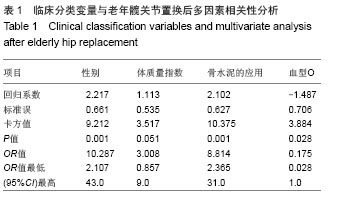| [1]武成兴,吴军,张蜀平,等.老年髋关节置换术后深静脉血栓形成的危险因素研究[J].现代预防医学,2012,39(21):5728-5729.[2]张纪,周一新,周乙雄.髋关节置换术中股骨假体周围骨折危险因素的分析[J].中华关节外科杂志(电子版),2010, 4(4): 488-493.[3]谭钢,罗磊,杨静,等. 3664例全髋关节置换术相关危险因素分析[J].中国矫形外科杂志,2011,19(17):1431-1434.[4]杨再丰,郑满红.人工全髋关节置换术治疗老年髋关节疾病54例疗效观察[J].中国社区医师(医学专业),2012,14(10): 108-109.[5]吕亮,王福生,卢敏,等.人工髋关节置换术后感染的危险因素分析及预防[J].中华医院感染学杂志,2013,23(6):1334-1335, 1345.[6]陈剑锋,陈安民,郭风劲,等.干骺端全髋关节置换术13例临床效果分析[J].中国全科医学,2010,13(32):3668-3670.[7]樊敏,钱天逸.全髋关节置换术在髋关节疾病治疗中的应用[J].吉林医学,2011,32(4):660-661.[8]陈银海.髋关节置换术后的康复[J].现代康复,2001,5(10):12-13.[9]邱贵兴.骨与关节外科新近展[J].临床外科杂志,2007,15(1): 33-36.[10]唐天生,张毅,林达强.髋关节置换术后深静脉血栓56例分析[J].健康必读,2012,6(6):14.[11]王昭佩,张雪飞.活血化瘀中药预防髋关节置换术后深静脉栓塞的体会[J].中医药学刊,2005,23(12):2147.[12]梁双.人工髋关节置换术后并发症的研究进展[J].华北煤炭医学院学报,2007,9(2):169-171.[13]杨述华,邱贵兴.关节置换外科学[M].北京:清华大学出版社, 2005: 44.[14]章洪喜,丁华,周云,等.全髋置换治疗老年人髋关节疾患的疗效观察[J].中国伤残医学,2008,16(4):15-16.[15]王玮,沈惠良,曹光磊.65岁以上老年骨科患者手术风险因素评估[J].中国矫形外科杂志,2006,14(6):425-427.[16]Geerts WH, Heit JA, Clagett GP,et al.Prevention of venous thromboembolism.Chest. 2001;119(1 Suppl):132S-175S.[17]杨玉辉,王金成,高忠礼,等.髋关节成形术治疗高龄股骨颈骨折315例临床分析[J].中国老年学杂志,2007,27(17):1714-1716.[18]傅勇,叶蜀新,朱莺鹰,等.全髋关节置换术后早期并发症探讨[J].四川医学,2006,27(1):18-19.[19]Ogston D, Mcandrew GM.Fibrinolysis in obesity. Lancet. 1964; 2(7371):1205-1207.[20]Haake DA, Berkman SA.Venous thromboembolic disease after hip surgery. Risk factors, prophylaxis, and diagnosis.Clin Orthop Relat Res. 1989;(242):212-231.[21]Moran CG, Wenn RT, Sikand M,et al.Early mortality after hip fracture: is delay before surgery important.J Bone Joint Surg Am. 2005;87(3):483-489.[22]Sund R, Liski A.Quality effects of operative delay on mortality in hip fracture treatment.Qual Saf Health Care. 2005;14(5): 371-377.[23]王玲.人工全髋关节置换围手术期护理[J].实用临床医药杂志, 2010,14(8):75-76,80.[24]江雪莲,郭小玲,王玉平.成人全髋关节置换术后早期脱位的康复护理[J].中国康复,2005,20(5):320.[25]赵艳梅.老年股骨颈骨折髋关节置换术后的护理[J].新乡医学院学报,2010,27(1):84-85.[26]Hardwick ME, Colwell CW Jr.Advances in DVT prophylaxis and management in major orthopaedic surgery.Surg Technol Int. 2004;12:265-268.[27]邱贵兴,戴尅戎,杨庆铭,等.预防骨科大手术后深静脉血栓形成的专家建议--深静脉血栓形成预防座谈会纪要[J].中华骨科杂志, 2005,25(10): 636-640.[28]吕厚山,林剑浩.现代人工关节外科学[M].北京:人民卫生出版社, 2006:613.[29]贾曼,吕畅,金丽雅.高龄患者一期双侧髋关节置换术的围手术期护理[J].护士进修杂志,2012,27(4):332-333.[30]黄涛,薛刚,赵琳.高龄患者全髋关节置换术围手术期并发症防治对策[J].中国实用神经疾病杂志,2009,12(19):67.[31]张明,乐国平.高龄患者髋关节置换围手术期危险因素处理的临床研究[J].中国矫形外科杂志,2009,17(17):1349-1351.[32]刘治摘译.根据全身状态确定老年人股骨颈骨折的手术适应证[J].国外医学:外科学分册,1983,8(4):30.[33]王福权,骆燕禧,黄公怡,等.老年四肢骨折的内固定治疗[J].中华骨科杂志,1991,11(4):242.[34]危杰,毛玉江,贾正中.中空加压螺丝钉治疗新鲜股骨颈骨折212例[J].中华创伤杂志,2000,16(3):142-144.[35]陆凯,李民.老年髋部骨折围手术期处理中几个问题的探讨——附246例分析[J].骨与关节损伤杂志,1996,11(1):24.[36]许学猛,孔畅,许树柴,等.高龄患者人工股骨头置换术围手术期应注意的问题探讨:附77例分析[J].实用医学杂志,1997,13(3): 145-147.[37]郭林,杨柳.人工全髋关节置换术患者145例近期疗效随访分析[J].中国临床康复,2003,7(26):3618-3620.[38]郝鹏,裴福兴.人工髋关节置换术的进展[J].现代预防医学,2007, 34(3):537-539.[39]邹华章,刘大柱,佟方明,等.老年髋关节置换术后下肢深静脉血栓的预防[J].中国骨与关节损伤杂志,2006,21(8):632-634.[40]刘汉江,唐中尧,茶晓峰.高龄患者全髋关节置换术围手术期并发症风险因素分析及对策[J].现代诊断与治疗,2013,24(3): 524-525.[41]郑国富.老年患者人工髋关节置换围手术期风险因素分析及处理[J].中医正骨,2011,23(2):46-48.[42]杜娟,鲁维丽.高龄老人全髋关节置换围手术期的护理干预[J].中国社区医师(医学专业),2012,14(32):302.[43]郭亭,赵建宁,王与荣.高龄患者行人工髋关节置换术围手术期并发症相关因素分析[J].中国临床康复,2004,8(5):830-831.[44]祝增奇,李寿龙,张永鹏.髋关节疾病髋关节置换43例治疗体会[J].中国保健营养,2013,23(1):184.[45]汤凌,朱剑,何双建,等.老年患者人工髋关节置换术的风险因素分析及处理[J].吉林医学,2011,32(36):7797-7798.[46]张京新,马仲峰.老年移位型股骨颈骨折手术后疗效及生活质量的比较[J].中国矫形外科杂志,2006,14(16):1210-1212, 1217.[47]王裕民,胡永成,李欣,等.老年伴有并存症的股骨颈骨折髋关节置换疗效分析[J].中国矫形外科杂志,2005,13(16):1215-1218.[48]张明.人工髋关节置换术前并存症及处理分析(附116例分析)[J].广西医科大学学报,2006,23(1):117.[49]钟环,郑鸿,陈继铭,等.全髋关节置换术后深静脉栓塞发生的相关因素研究[J].中国实验诊断学,2012,16(6):1058-1061.[50]魏玉莲.全髋关节置换术后深静脉血栓形成的多因素Logistic回归分析[J].中国保健营养:中旬刊,2012,(8):2-3. [51]武成兴,吴军,张蜀平,等.老年髋关节置换术后深静脉血栓形成的危险因素研究[J].现代预防医学,2012,39(21): 5728-5729.[52]刘军,沈飞,黄际河.全髋关节置换术后深静脉血栓形成的危险因素分析[J].昆明医学院学报,2012,33(7):84-87.[53]胡文娟.髋关节置换术后下肢深静脉血栓形成的危险因素分析[J].国际医药卫生导报,2012,18(2):261-263.[54]张晓文.全髋关节置换术后下肢深静脉血栓危险因素分析及防治[J].中国医刊,2011,46(9):61-63.[55]臧学慧,查振刚,高立华,等.全髋关节置换后早期并发深静脉血栓的多因素Logistic回归分析[J].中国组织工程研究与临床康复,2010,14(17):3054-3057.[56]陈忠华,蒋宗明,郑羡,等.河髋关节置换术后患者下肢深静脉血栓形成的危险因素[J].河北医科大学学报,2010,31(3):311-313.[57]马俊,沈彬,杨静,等.人工全髋关节置换术后下肢深静脉血栓形成的危险因素分析[J].中国矫形外科杂志,2009,17(13):965-969.[58]顾海伦,王欢,段景柱,等.人工全髋关节置换术后下肢深静脉血栓形成的多因素分析[J].中国骨伤,2007,20(9):611-613.[59]关振鹏,吕厚山,陈彦章,等.影响人工关节置换术后下肢深静脉血栓形成的临床风险因素分析[J].中华外科杂志,2005,43(20): 1317-1320. |
